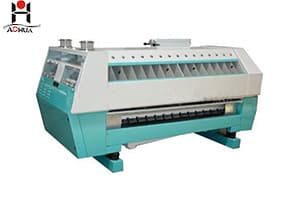- Whatsapp:+86-13949074923
- Email: AoHua@aohuascreeningmachine.com
Products list
inquery
purifier machine
2022-02-19
Purifying and classifying in-process products (wheat residue, wheat heart or coarse meal) with similar particle size according to quality is called clear powder.
The slag core material extracted by the flat screen often contains a small amount of bran or endosperm with the same particle size. Such material is sent to the core mill for grinding, which will have an adverse effect on the quality of the flour. The purpose of cleaning is to separate broken bran and pure flour, improve flour quality and reduce material temperature. The pure powder obtained by clearing the powder is sent to the heart to grind the powder.
(2) Equipment for cleaning powder
The equipment used for cleaning powder is a powder cleaning machine.
The cleaning powder is carried out by the combination of sieving and air suction. The air cleaning equipment is mainly composed of sieve grid and air suction device. When working, the sieve grid vibrates, separates the material and loosens the material on the sieve, which increases the efficiency of suction and cleaning. The airflow blows up the fine bran and contiguous bran flour in the material from under the sieve, and enters into different collectors respectively.
(3) Evaluation of the effect of cleaning powder

The effect of the purifier is generally evaluated comprehensively by the screening rate and the ash reduction rate.
1. Screening rate: refers to the percentage of the material flow under the screen of each section of the purifier to the material flow in the machine. Other conditions are the same, and the equipment with high screening rate is effective.
2. Ash reduction rate: Refers to the degree to which the ash content of the under-sieve material is reduced compared to the incoming material after the material is cleaned. Other conditions are the same, the effect is better when the ash reduction rate is high.
In general, the quality of the incoming materials is good, the sifting rate after cleaning is high, and the ash reduction rate is low; for materials with poor quality and many skin layers, the ash reduction rate after cleaning is high, and the screening rate is low. When the effect is achieved, a comprehensive evaluation of the two indicators is required.